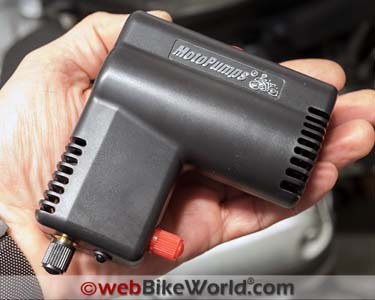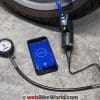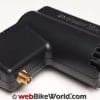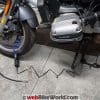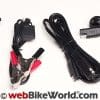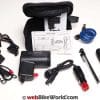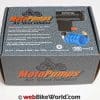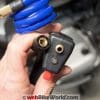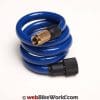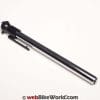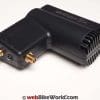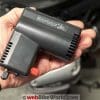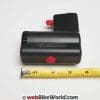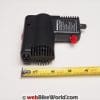The MotoPumps Air Shot is a very compact tire inflator.
It provides pressures up to 100 psi and it’s small enough to fit under the seat of many motorcycles.
The kit has everything needed to inflate a tire at the roadside.
Multiple power cables, a zero-loss air hose and even a stick-type air pressure gauge is included.
Drawing less than 5A, the MotoPumps Air Shot is even suitable for a motorcycle with a low-capacity battery.
The air pump is quiet and does not get hot even after five minutes of continuous use.
All of this comes packed in a small Cordura case with a little room left over to fit a tire repair kit if desired.
Like it or not, getting a tire puncture is one of those things that is very likely going to happen to you if you ride long enough.
It seems uncanny but despite the smaller contact patch and the single track nature of a motorcycle, I think I’ve had at least as many punctures on motorcycle tires than on car tires.
I’ve gone maybe 85 to 90 thousand miles since I’ve been riding and I’m sure that’s a small fraction of the amount of miles I’ve driven in cars and trucks over the years.
It seems like nails and screws must just be attracted to motorcycle tires…
Fortunately for me, none of the punctures I’ve had on my bike were catastrophic and all were discovered while the bike was at home.
Despite my good-ish fortune here, I always make certain I’ve got a tire repair kit on board the bike and a way to inflate the tire after repair.
For years I’ve kept the small CO2 cartridge type inflator with extra cartridges under the seat or stowed somewhere on the bike.
These small inflators will do the job and they are easy to store.
However, they may not be enough to fully inflate a rear tire unless you carry several cartridges and even then, a mistake with the tire plug could use up all the CO2 and then you’d be stuck.
For a while, I carried a small CO2 inflator that also included a small hand air pump just in case.
The small pump was designed primarily for bicycle tires but with enough time and effort it could inflate a motorcycle tire.
If there was a better and more compact way though, I’d certainly be interested. Enter the MotoPumps Air Shot.
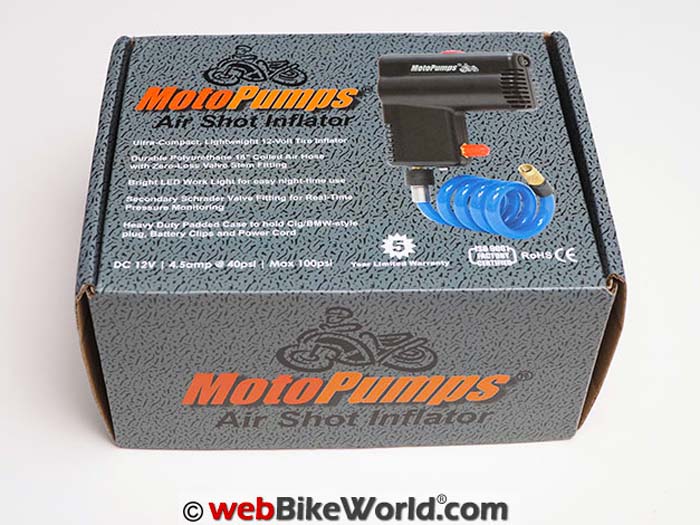
MotoPumps
The Air Shot is an electric air pump tire inflator from MotoPumps, a company I became familiar with through a popular adventure riding forum.
MotoPumps has been selling compact tire inflators since 2005 and their lineup includes the Air Shot and the larger, yet still compact, Mini Pro.
The Air Shot is also sold under the Dynaplug brand name as the Dynaplug Ultra Compact tire inflator and to make things a bit more confusing, there’s also a Dynaplug Mini Pro version of the MotoPumps Mini Pro.
[UPDATE (From Dynaplug): “Rob Bandler at MotoPumps is our long term customer and partner in inflator design. To clarify, Dynaplug sells to MotoPumps and puts their label on the product.We also take responsibility for the larger inflator Mini Pro GT that is shown in your review.”]
But back to the Air Shot… One has to wonder looking at the diminutive device how they crammed all the needed hardware into that small space. Let’s take a closer look.
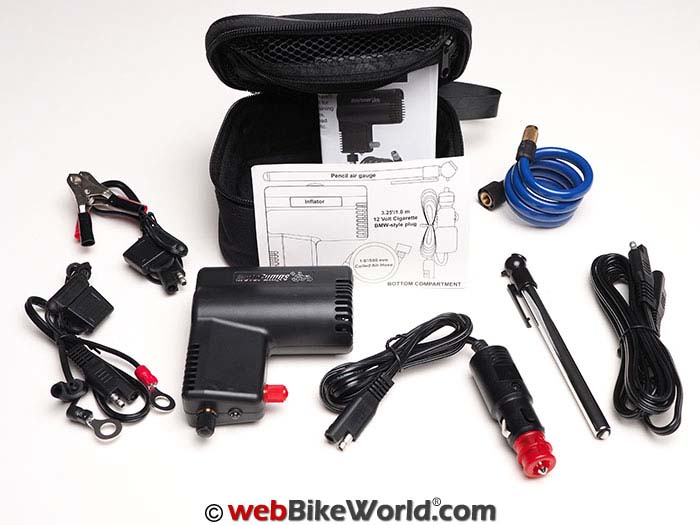
The AirShot Inflator
One of the ways that MotoPumps maintains the small size of the Air Shot compressor is to make almost everything on it removable.
On their larger Mini Pro air pump, the air hose and power cable storage are in the unit housing and it also has an integrated air pressure gauge.
The Air Shot inflator body only contains the pump, fittings, and a small LED work light; the main air hose and power cables are detached and there is no pressure gauge in the unit itself.
The separation of these parts from the compressor housing makes the Air Shot small enough to store just about anywhere.
Since the hoses and cables are not connected to the pump, they can more easily be stowed wherever space is available if necessary (clever).
The Air Shot air pump looks like tiny, pistol-style hair dryer and at the end of what might be considered “the barrel” is a standard SAE connector for power.
The Air Shot has a maximum current draw of only 5 Amps, so even a smaller bike with a lower-capacity battery should be able to power the pump safely.
On the top of the “barrel” is a large red push-button for turning on and off the compressor.
This is a nice touch for a such a small device as it would have been simpler (but less convenient I think) to just have the pump power up as soon as the power was connected.
On the lower portion of the unit, what would be considered “the grip” in the pistol metaphor, are two output connections.
The lower one with the black cap is for connecting to the included air hose, while the other connector with the red cap is a Schrader valve.
This connection is used for taking pressure readings without having to remove the air hose from the tire.
A stick type pressure gauge is included with the Air Shot but you can use whatever gauge you prefer.
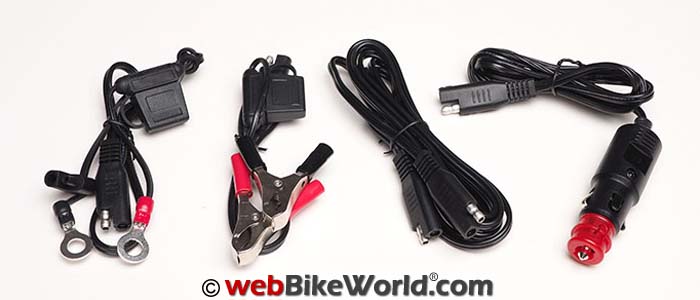
Dimensions
There isn’t a lot of space under the rear seat of my Kawasaki Ninja 1000 (review). There’s just enough room to store a tire repair kit, my old CO2 inflator (with the tiny built in hand pump) and three cartridges.
After removing that however, I placed the Air Shot kit into place under the seat and discovered that I was also able to store the air hose and the included SAE power cable with no trouble at all (in the space at the rear, under the passenger seat).
If given the choice to mess with cartridges and the little hand pump versus an electric inflator, electric is going to win hands down.
The body of the Air Shot pump measures about 8.9 cm by 10.15 cm (3.5 by 4 inches) and the pump fits pretty easily in the hand.
What’s Included
The Air Shot Inflator comes with a compliment of accessories and connectors that should make it usable on most any motorcycle.
All of the pieces fit in a small Cordura storage case along with the Air Shot air pump.
Included is a blue 18 inch coiled air hose, a 6 foot long SAE to SAE cable, a ring terminal to SAE cable, a battery clip to SAE cable, a convertible cigarette (Euro/BMW/Powerlet) style to SAE cable, and finally the aforementioned stick-type air gauge.
The entire kit contents including the case weighs in at just over 0.5 kilogram (18 oz.), with the air pump itself coming in at just 170 grams (6 oz.).
This small amount of mass should be safe to store in most any piece of motorcycle luggage as well as under-seat storage locations.
The carrying case easily holds all of these cables and it also leaves some room for something like a Dynaplug tire plugging kit.
Unfortunately, the case is a little too bulky to store under the seat of the Ninja. To save space, but still protect the Air Shot from the elements, I placed it in a small Ziploc bag.
The air hose and power cable are stuffed under the seat next to the inflator, leaving room the factory tool kit.
While I appreciate the catch-all approach to the included Air Shot kit, I think an option where just the Air Shot pump could be ordered, along with one power cord and the air hose would appeal to some riders.
I have plenty of SAE connectors and cables for motorcycle use and my limited under seat space means I don’t really need to storage case either.
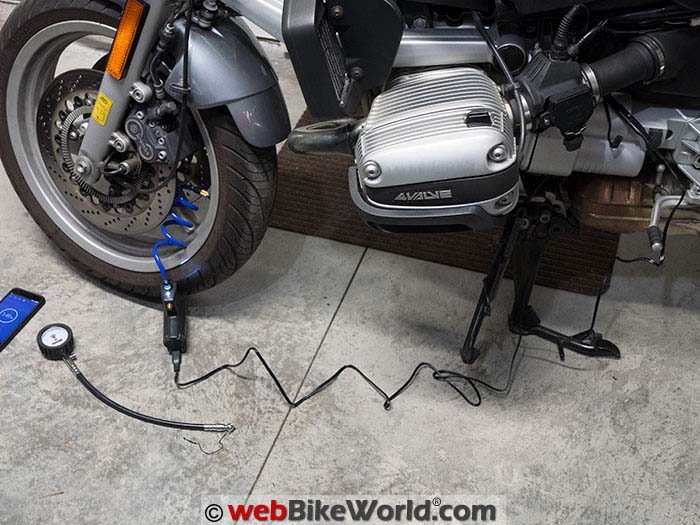
A Note on Customer Service
I had heard that customer service from MotoPumps was excellent, so to test this, I reached out to them to ask about a the idea of a more basic kit being available.
Within twenty minutes they had responded and informed me that they would be glad to do this and could do this for other customers who would be interested.
They also asked me what bike I had so that they could provide a smaller case that would fit.
This type of quick, friendly, and helpful response is indicative what has helped build this customer service reputation I’d heard about.
I thanked them for their quick response and let them know I already had an Air Shot of my own but that I’d like to let others know about that option if asked.
It is important to point out that they did not know that I was writing a review; I just went about this inquiry and my original purchase of the Air Shot only as an anonymous customer.
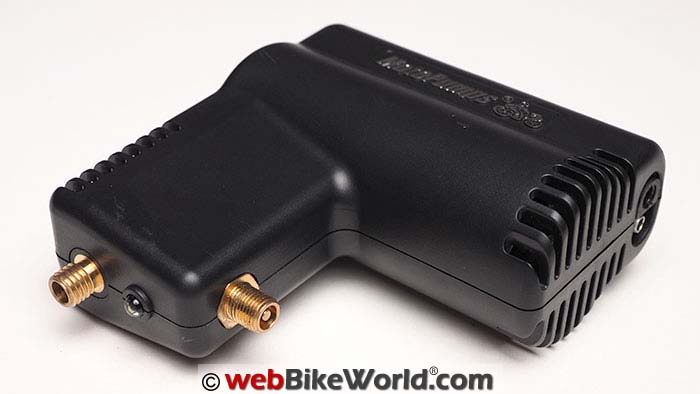
Performance From Flat
Let’s get down to a real test.
Yes, the Air Shot kit fits in a small space and it has all the necessary bits and pieces to get you going right out of the box, but this means nothing if the pump doesn’t work well.
So with that said, it’s time to let the air out of a tire.
For this test, I put a BMW R 1100 R up on its center stand and proceeded to remove the valve stem from the 120/70-17 front tire.
I did this to make certain that all of the air was out of the tire before starting.
After replacing the valve stem, I connected the blue hose from the kit to the Air Shot and then I connected the power cord to an SAE outlet that was previously installed on the bike.
Next, I started a stopwatch timer app and hit the power button on the Air Shot.
MotoPumps claims the Air Shot will “inflate a completely flat motorcycle tire in approximately 5 minutes”. No specific tire size or pressure is called out, but the range of tire size combinations (and air volume) is huge.
So as the Air Shot hummed away, I timed how long it took to reach 36 PSI (2.5 Bar).
There is always some potential for variation, as the battery level of the bike can also affect the performance of the pump, so for this example, I had left the BMW’s battery on a maintenance charger for several days prior.
Thus, this will be indicative of a fully charged battery, but the engine will not be running.
As the Air Shot worked, I also checked the sound levels, more out of curiosity than anything else, but it may be of interest to some of the more technical “geeks” out there (like me).
Using the pressure check fitting built into the Air Shot, I used my own dial air pressure gauge to monitor the pressure as the inflator worked to re-inflate the tire.
So how about the claim that it takes about five minutes to re-inflate the average tire? In this test, it ended up taking 4 minutes and 51 seconds to reach 36 PSI — that’s right on the money.
Not a bad performance, especially when you consider how little effort the process took.
The air hose provided in the kit also has a nice zero-loss screw-type connector, so no air is lost when the hose is disconnected.
There is a small “pfffftt” sound as the hose is removed, probably from the air pressure remaining in the hose.
Tire Top-Up Performance
I also wanted to test how long it takes to add a few PSI to an under-inflated tire, so I lowered the tire pressure to 31 PSI (2.2 Bar) and then used the Air Shot to bring it back up to 36 PSI.
This took only 29 seconds for the 120/70-17 tire.
While the Air Shot was running, I also measured the noise level with a smartphone app. It indicated 82 dB at three feet. Not too noisy and that was in my garage against a concrete floor.
UPDATE: Inflation With Bike on Side Stand
A webBikeWorld reader writes “I read your review with interest, but have a comment. In your testing you pumped up a flat tire with no weight on it.
Most of us riders don’t have a bike with a center stand so after finding and fixing the cause of the flat I am left with trying to pump up a tire with the full weight of the bike on it. I would be interested in how this pump performed that kind of test.”
Brandon’s Results: It actually takes less time to inflate to correct pressure with the weight of the bike on the tire: 4:28 vs. 4:51.
I thought about this for a minute and it makes perfect sense.
The weight of the bike DOES affect the pressure inside the tire. As the bike itself presses down on the tire, any existing pressure will be increased slightly.
This does not have an adverse effect on the performance of the pump and it would reduce the time to inflate to a designated pressure setting.
To test this, I checked the pressure with the tire unloaded with the bike on the center stand and then with it on the side stand.
The tire was at 36 PSI on the side stand but when I unloaded it and checked again, it was 34.5 PSI. Once on the side stand again it went back to 36 PSI.
I’m going to assume that that last 1.5 PSI would take around 20 or so seconds to get out of the Air Shot.
Summary: With the tire unloaded, it took 4:51 to reach 36 PSI. Tire under load of 1995 BMW R 1100 R it took4:28 to reach 36 PSI.
Air Pump Temperature
I used an infrared temperature gauge to see how hot the pump became during the inflation.
The hottest location on the casing was just 29C (84F), which is relatively cool for having run for nearly five minutes.
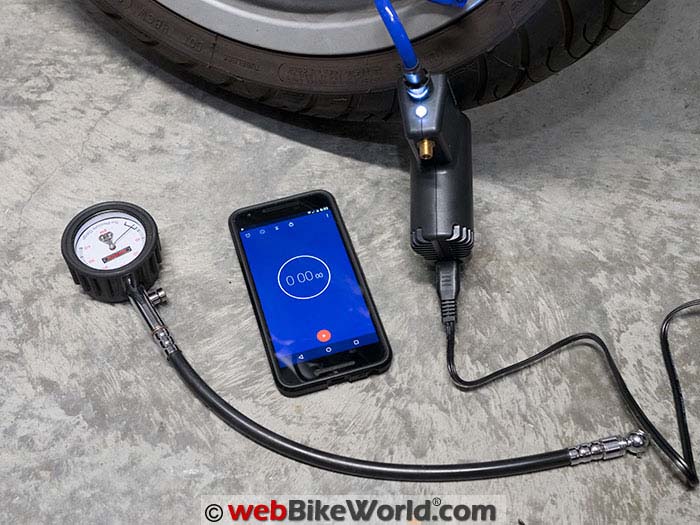
Conclusion
The MotoPumps Air Shot deserves the title small wonder in my opinion.
The compact body should fit in the built-in storage of most motorcycles and the standard kit includes all the power connectors one could ask for.
Also provided is a tire air pressure gauge and it all fits in a small case that would take little space on your average touring or sport-touring bike.
Even more restricted storage locations (like on my Ninja 1000) will be able to handle the inflator and necessary accessories in the under-seat space.
By the way, one of the nice things about having a pump like this on hand is that if you are on a trip, you don’t have to rely on a fuel station having an air pump handy so you can adjust the tire pressure if needed.
You can make an adjustment any time and you won’t have to pay the dollar (or more) that they charge in the U.S. for accessing the station air pump.
For those riders who may use high-pressure inserts in place of traditional tubes, I understand that the Air Shot tops out at 100 PSI (6.9 Bar), so it can be used to inflate these to full pressure. .
My original tire repair kit and CO2 inflator was something I kept with me on the bike but hoped that I would never have to use.
Having the Air Shot with me is different; I actually like the chance to break it out and show off this neat little device, assuming of course I only am topping up and not fixing a flat.
The $59.95 price for the Air Shot inflator seems like a great deal to me. The inflator itself is solid and the included hardware is comprehensive.
The cost is certainly worth the peace of mind of knowing I have that pump along for the ride.
One last thing to consider is the customer service aspect of MotoPumps; they have been very responsive and friendly in all of my communications with them.
And I nearly forgot to mention that the Air Shot is covered by a five year warranty.
More webBikeWorld:
| wBW Review: MotoPumps Air Shot | |
|---|---|
| Manufacturer: MotoPumps | List Price (2017): $59.95 |
| Colors: Black | Made In: China |
| Review Date: January 2017 | |
Owner Comments and Feedback
See details on submitting comments.
From “R.T.” (February 2017): “Video was very good! I bought one per your recommendation. Works well!”
From “A.N.” (January 2017): “After reading the review, I immediately got on line and ordered one thru Amazon. When I received it, I was impressed and tried it out.
There are only a few things I would like to mention.
First and foremost, I’ve found that when disconnecting the air hose from the wheel it will lose anywhere from 2 to 4 pounds. So I’ve had to increase the pressure to obtain the required level.
I suspect it may be an air hose issue and plan to contact them to see what they think.
I have to admit it took me a while to figure out that initially the air hose had to be tightened down considerably to keep the air from leaking! It appears that the 2 to 4 lbs. drop in pressure occurs when unscrewing the hose from the wheel.
This could a result of the operator not removing the hose fast enough. So I will contact the manufacturer and ask them if there is a possible quick release option.
The only other thing I would mention, is that little puppy does get warm — not to say that’s bad; on a cold day that’s a plus!
Also, the kit fits perfectly under the rear seat of my 2016 Triumph Tiger 800 XRT.
Bottom line: this is a good quality pump that is good for routine tire maintenance and on the road emergencies. I would definitely recommend it to a friend!”
From “R.T.” (January 2017): “Good review! Just ordered one.”
From “B.H.” (January 2017): “The MotoPumps Air Shot looks like a great product. I was wondering if they could also come up with optional hoses or adapters to use for blowing up air mattresses that we use when camping on our bike trips.
This would make it a great ‘dual purpose’ pump.”


